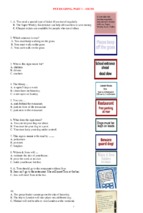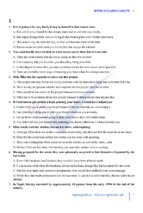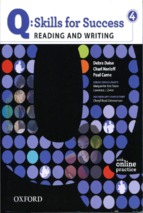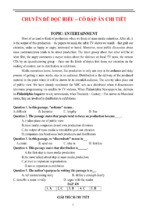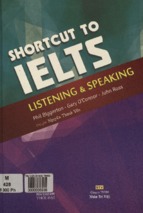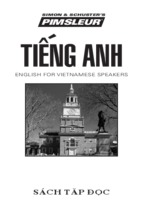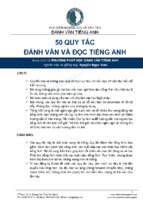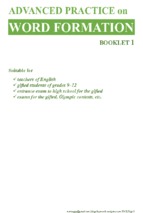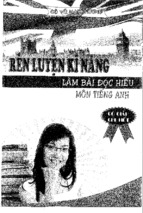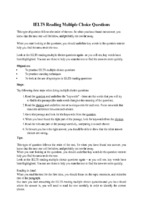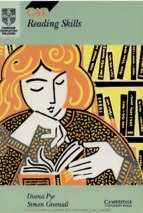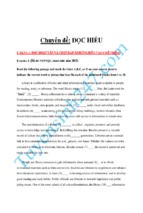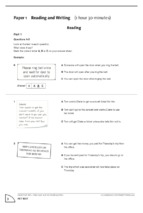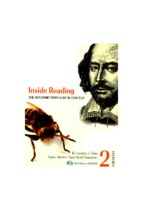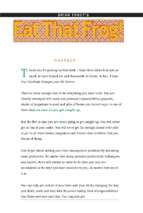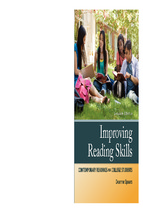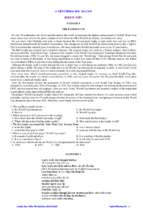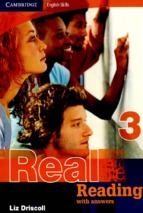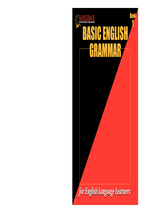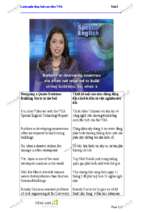ENG2C_ WRITTEN PROFICIENCY _ READING COMPONENTS
THAI NGUYEN UNIVERSITY
FACULTY OF FOREIGN LANGUAGES
English Department
----------------------------------------
Compiled by:
VIET HAI NGUYEN_ K36 FEL & TELE_ FFL_TNU
ENGLISH FOR SKILLS &
ACADEMIC PURPOSES
LEVEL 2
(ENG2A & C_ READING COMPONENTS)
(For internal use only)
1
VIET HAI NGUYEN_ K36 FEL & TELE_ FFL_TNU
Thai Nguyen, July, 2015
ENG2C_ WRITTEN PROFICIENCY _ READING COMPONENTS
PROCEDURES FOR A READING PASSAGE
1. Scroll through the reading passage to determine the main idea and the overall
organization of ideas in the passage. You do not need to understand every detail in each
passage to answer the questions correctly. It is therefore a waste of time to read the
passage with the intent of understanding every single detail before you try to answer the
questions.
2. As a question comes up on the screen, look at the language skill that is being
tested. The language skill tells you exactly where to look in the passage to find correct
answers.
• For main idea questions, look at the first line of each paragraph.
• For click-on-a-paragraph questions, look at the first line of each paragraph.
• For directly and indirectly answered detail questions, choose a key word in the
question, and skim for that key word (or a related idea) in order in the passage.
• For pronoun questions, the pronoun will be highlighted in the passage.
• For transition questions, look at the beginning or the end of the passage.
• For vocabulary questions, the vocabulary will be highlighted in the passage.
• For click-on-a-sentence questions, the paragraph where the answer can be found is
given in the question.
• For tone, purpose, and course questions, look at the first line of each paragraph.
• For insertion questions, look at the context before and after each insertion box.
READING
3. Read the part of the passage that contains the answer carefully. The answer will
probably be in a very predictable place in the passage.
4. Choose the best answer to each question. You can choose the best answer according
to what is given in the appropriate section of the passage, or you can eliminate definitely
wrong answers and select your best guess.
5. Click on the answer on the computer screen when you have selected an answer. You
may still change your mind at this point and click on a different answer. You may also
return later to a question within the same reading passage (although it can be timeconsuming to click back through too many questions).
Next, you should move on to the language skills. The following language skills will help
you to implement these strategies and procedures in the reading section of both the
paper TOEFL test and the computer TOEFL test.
2
VIET HAI NGUYEN_ K36 FEL & TELE_ FFL_TNU
ENG2C_ WRITTEN PROFICIENCY _ READING COMPONENTS
QUESTIONS ABOUT THE IDEAS OF THE PASSAGE
It is very common for reading passages in the reading section of both the paper TOEFL
test and the computer TOEFL test to have questions about the overall ideas in the
passage. The most common type of question asks about the main idea, topic, title, or
subject. There may also be questions about how the information in the passage is
organized or about which type of information is included in a particular paragraph.
SKILL I: ANSWER MAIN IDEA QUESTIONS CORRECTLY
Almost every reading passage on the paper TOEFL test or computer TOEFL test will have
a multiple-choice question about the main idea of a passage. Such a question may be
worded in a variety of ways; you may, for example, be asked to identify the topic,
subject, title, primary idea, or main idea. These questions are all really asking what
primary point the author is trying to get across in the passage. Since TOEFL passages are
generally written in a traditionally organized manner, it is relatively easy to find the main
ideas by studying the topic sentences, which are most probably found at the beginning of
each paragraph. If a passage consists of only one paragraph, you should study the
beginning of that paragraph to determine the main idea. Look at a multiple-choice
example from the paper TOEFL test that asks about the topic of a passage with one
paragraph.
READING QUESTIONS (PAPER AND COMPUTER)
Example from the Paper TOEFL Test
The passage 1:
In the philosophy of John Dewey, a sharp distinction is made between intelligence and
reasoning. According to Dewey, intelligence is the only absolute way to achieve a balance
between realism and idealism, between practicality and wisdom of life. Intelligence
involves "interacting with other things and knowing them," while reasoning is merely the
act of an observer, "... a mind that beholds or grasps objects outside the world of things "
With reasoning, a level of mental certainty can be achieved, but it is through intelligence
that control is taken of events that shape one's life.
The question:
What is the topic of this passage?
(A) The intelligence of John Dewey
(B) Distinctions made by John Dewey
(C) Dewey's ideas on the ability to reason
(D) How intelligence differs from reasoning in Dewey's works
3
VIET HAI NGUYEN_ K36 FEL & TELE_ FFL_TNU
ENG2C_ WRITTEN PROFICIENCY _ READING COMPONENTS
This question asks about the topic of the passage. Because this passage has only one
paragraph, you should look at the first sentence of the passage to answer this question.
The first sentence of this passage discusses a distinction between the ideas of intelligence
and reasoning m the philosophy of John Dewey, so this is probably the topic. A quick
check of the rest of the sentences in the passage confirms that the topic is in fact the
difference between intelligence and reasoning. Now you should check each of the
answers to determine which one comes closest to the topic that you have determined.
Answer (A) mentions only intelligence, so it is not the topic. Answer (B) mentions
distinctions that John Dewey made, but it does not say specifically what type of
distinctions. Answer (C) mentions only reasoning, so answer (C) is incomplete. The best
answer is therefore (D); the idea of how intelligence differs from reasoning comes from
the first sentence of the passage, which mentions a sharp distinction. . . between
intelligence and reasoning.
If a passage consists of more than one paragraph, you should study the beginning of
each paragraph to determine the main idea. Look at a multiple-choice example from the
computer TOEFL test that asks about the title of a passage with more than one
paragraph.
The passage 2:
Nitrogen fixation is a process by which nitrogen is continuously fed into biological
circulation. In this process, certain algae and bacteria convert nitrogen into ammonia(NH
3 ).This newly-created ammonia is then for the most part absorbed by plants.
The opposite process of denitrification returns nitrogen to the air. During the
process of denitrification, bacteria cause some of the nitrates from the soil to convert
into gaseous nitrogen or nitrous oxide (N 2 0). In this gaseous form, the nitrogen returns
to the atmosphere.
The question:
Which of the following would be the best title for this passage?
(A) The Process of Nitrogen Fixation
(B) Two Nitrogen Processes
(C) The Return of Nitrogen to the Air
(D) The Effect of Nitrogen on Plant Life
This question asks you about the best title for the passage. In a passage with more than
one paragraph, you should be sure to read the first sentence of each paragraph to
determine the subject, topic, title, or main idea. In this example, the first sentence of the
first paragraph indicates that the first paragraph is about the process of nitrogen fixation.
4
VIET HAI NGUYEN_ K36 FEL & TELE_ FFL_TNU
ENG2C_ WRITTEN PROFICIENCY _ READING COMPONENTS
If you look only at the first paragraph, you might choose the incorrect first answer, which
would be a good title for the first paragraph only. The first sentence of the second
paragraph indicates that the process of denitrification is discussed in the second
paragraph. The third answer is incorrect because the return of nitrogen to the air is the
process of denitrification, and this is discussed in the second paragraph only. The last
answer is incorrect because the effect of nitrogen on plant life is not discussed in this
passage. The best answer to this question is the second answer; the two nitrogen
processes are nitrogen fixation, which is discussed in the first paragraph, and
denitrification, which is discussed in the second paragraph.
The following chart outlines the key information that you should remember about main
idea questions:
MAIN IDEA QUESTIONS
HOWTO IDENTIFY THE What is the topic of the passage?
QUESTION
What is the subject of the passage?
What is the main idea of the passage?
What is the author's main point in the passage?
With what is the author primarily concerned?
Which of the following would be the best title?
WHERE TO FIND
The answer to this type of question can generally be
THE ANSWER
determined by
looking at the first sentence of each paragraph.
HOW TO ANSWER
1 . Read the first line of each paragraph.
THE QUESTION
2. Look for a common theme or idea in the first lines.
3. Pass your eyes quickly over the rest of the passage to
check that you have really found the topic sentence(s).
4. Eliminate any definitely wrong answers and choose the
best answer from the remaining choices.
TOEFL EXERCISE 1: Study each of the passages and choose the best answers to the questions that follow. In this exercise, each passage is followed by several main idea, topic, or
tide questions so that the students can practice this type of question. On the TOEFL test,
one passage would probably not have two such questions because they are so similar.
PASSAGE ONE (Questions 1-2)
5
VIET HAI NGUYEN_ K36 FEL & TELE_ FFL_TNU
ENG2C_ WRITTEN PROFICIENCY _ READING COMPONENTS
Fort Knox, Kentucky, is the site of a U.S. army post, but it is even more renowned for the
Fort Knox Bullion Depository, the massive vault that contains the bulk of the U.S.
government's gold deposits. Completed in 1936, the vault is housed in a two-story
building constructed of granite, steel, and concrete; the vault itself is made of steel and
concrete and has a door that weighs more than twenty tons. Naturally, the most up-todate security devices available are in place at Fort Knox, and the army post nearby
provides further protection.
1. Which of the following best describes 2. Which of the following would be the
the topic of the passage?
best title for this passage?
(A) The city of Fort Knox, Kentucky
(A) The Massive Concrete Vault
(B) The federal gold depository
(B) Fort Knox Security
(C) The U.S. army post at Fort Knox
(C) Where the United States Keeps Its Gold
(D) Gold bullion
(D) A Visit to Kentucky
PASSAGE TWO (Questions 3-4)
One identifying characteristic of minerals is their relative hardness, which can be
determined by scratching one mineral with another. In this type of test, a harder mineral
can scratch a softer one, but a softer mineral is unable to scratch the harder one. The
Mohs' hardness scale is used to rank minerals according to hardness. Ten minerals are
listed in this scale, ranging from talc with a hardness of 1 to diamond with a hardness of
10. On this scale, quartz (number 7) is harder than feldspar (number 6) and is therefore
able to scratch it; however, feldspar is unable to make a mark on quartz.
3. Which of the following best states the
4. The main idea of this passage is that
subject of this passage?
(A) the hardness of a mineral can be
(A) The hardness of diamonds
determined by its ability to make a mark on
(B) Identifying minerals by means of a
other minerals
scratch test
(B) diamonds, with a hardness of 10 on the
(C) Feldspar on the Mohs' scale
Mohs' scale, can scratch all other minerals
(D) Recognizing minerals in their natural
(C) a softer mineral cannot be scratched by
state
a harder mineral
(D) talc is the first mineral listed on the
Mohs' scale
PASSAGE THREE (Questions 5-6)
Hurricanes generally occur in the North Atlantic from May through November, with
the peak of the hurricane season in September; only rarely will they occur from
December through April in that part of the ocean. The main reason for the occurrence of
6
VIET HAI NGUYEN_ K36 FEL & TELE_ FFL_TNU
ENG2C_ WRITTEN PROFICIENCY _ READING COMPONENTS
hurricanes during this period is that the temperature on the water's surface is at its
warmest and the humidity of the air is at its highest.
Of the tropical storms that occur each year in the North Atlantic, only about five, on
the average, are powerful enough to be called hurricanes. To be classified as a hurricane,
a tropical storm must have winds reaching speeds of at least 117 kilometers per hour, but
the winds are often much stronger than that; the winds of intense hurricanes can easily
surpass 240 kilometers per hour.
5. The passage mainly discusses
6. The best title for this passage would be
(A) how many hurricanes occur each year
(A) The North Atlantic Ocean
(B) the strength of hurricanes
(B) Storms of the Northern Atlantic
(C) the weather in the North Atlantic
(C) Hurricanes: The Damage and
(D) hurricanes in one part of the world
Destruction
(D) What Happens from May through
November
PASSAGE FOUR (Questions 7-9)
Henry Wadsworth Longfellow (1807-1882) was perhaps the best-known American
poet of the nineteenth century. His clear writing style and emphasis on the prevalent
values of the period made him popular with the general public if not always with the
critics. He was particularly recognized for his longer narrative poems Evangeline, The
Song of Hiawatha, and The Courtship of Miles Standish, in which he told stories from
American history in terms of the values of the time.
Evangeline was set during the French and Indian War (1754-1763), when the British
forced French settlers from Nova Scotia; two lovers, Gabriel and Evangeline, were
separated by the British, and Evangeline devoted her lifetime to the search for Gabriel.
With its emphasis on sentimental, undying love, Evangeline was immensely popular with
the public.
In The Song of Hiawatha, Longfellow depicted the noble life of the American Indian
through the story of the brave Lf iawatha and his beloved wife Minehaha. The tearinspiring poem follows Hiawatha through the tragedies and triumphs of life, ending with
the death of Minehaha and Hiawatha's departure into the sunset in his canoe.
The Courtship of Miles Standish takes place during the early period of the settlement
of New England, a period which was viewed as a time of honor and romance. In this
poem centered around a love triangle, Miles Standish asks his friend John Alden to
propose to Priscilla Mullins for him; John Alden ends up marrying Priscilla Mullins himself,
and it takes time for his friendship with Miles Standish to recover. As with Longfellow's
7
VIET HAI NGUYEN_ K36 FEL & TELE_ FFL_TNU
ENG2C_ WRITTEN PROFICIENCY _ READING COMPONENTS
other narrative poems, the emphasis on high ideals and romance made the poem
extremely popular.
7. Which of the following best describes
8. The best title of the passage is
the main idea of the passage?
(A) Longfellow's Popular Appeal
(A) American history is often depicted in
(B) Historical Narrative Poems
poetry.
(C) The Lyric, Dramatic, and Narrative
(B) Longfellow described American history
Poems of Longfellow
even though people really did not enjoy it.
(D) Longfellow and the Critics
(C) The popularity of Longfellow's poems
9. The subject of the fourth paragraph is
results from his stress on the values of the
(A) nobility and honor in the poems of
people.
Longfellow
(D) Longfellow wrote long narrative poems (B) the love triangle involving Miles
that were not always popular with the
Standish
critics.
(C) the popular appeal of The Courtship of
Miles Standish
(D) the period of the early settlement of
New England
Skill 2: RECOGNIZE THE ORGANIZATION OF IDEAS
In the Reading section of both the paper TOEFL test and the computer TOEFL test, there
may be questions about the organization of ideas in a passage. On the paper and the
computer tests, you may be asked to determine how the ideas in one paragraph (or paragraphs) relate to the ideas in another paragraph (or paragraphs). On the computer TOEFL
test, you may also see a question that asks you to click on the paragraph in a passage that
contains certain ideas. Look at an example from the paper TOEFL test that asks
you to determine how the information in the passage is organized.
Example from the Paper TOEFL Test
The passage:
If asked who invented the game of baseball, most Americans would probably reply that it
was their belief that Abner Doubleday did. They believe this because the story about
Doubleday is part of the tradition of baseball.
Doubleday was given credit for this invention early in the twentieth century when
sporting-goods manufacturer Spaulding inaugurated a commission to research the
8
VIET HAI NGUYEN_ K36 FEL & TELE_ FFL_TNU
ENG2C_ WRITTEN PROFICIENCY _ READING COMPONENTS
question of who invented baseball. In 1908, a report was published by the commission in
which Abner Doubleday, a U.S. Army officer from Cooperstown, New York, was given
credit for the invention of the game. The National Baseball Hall of Fame was established
in Cooperstown in honor of Doubleday.
Today, most sports historians are in agreement that Doubleday really did not have much
to do with the development of baseball. Instead, baseball seems to be a close relative of
the English game of rounders and probably has English rather than American roots.
The question:
In this passage
(A) an idea is presented and then refuted
(B) a concept is followed by examples
(C) a cause is followed by an effect
(D) a belief is supported with reasons
This question is about how the information is organized in the passage. To answer this
question, it is necessary to look at the main ideas of each of the three paragraphs. The
main idea of the first paragraph is found in the first sentence of the first paragraph: that
if asked who invented the game of baseball, most Americans would probably reply that it
was their belief that Abner Doubleday did. The main idea of the second paragraph is
found in the first line of the second paragraph: that Doubleday was given credit for this
invention. The main idea of the third paragraph is found in the first line of the third
paragraph: that most sports historians are in agreement that Doubleday really did not
have much to do with the development of baseball. If you study the information in the
first lines of the paragraphs, you can determine that the third paragraph contradicts or
refutes the information that is presented in the first two paragraphs. Answer (A) is
therefore the best answer to this question.
Passage: TOEFL computer test:
If asked who invented the game of baseball, most Americans would probably reply that it
was their belief that Abner Doubleday did. They believe this because the story about
Doubleday is part of the tradition of baseball.
Doubleday was given credit for this invention early in the twentieth century when
sporting-goods manufacturer Spaulding inaugurated a commission to research the
question of who invented baseball. In 1908, a report was published by the commission in
which Abner Doubleday, a U.S. Army officer from Cooperstown, New York, was given
9
VIET HAI NGUYEN_ K36 FEL & TELE_ FFL_TNU
ENG2C_ WRITTEN PROFICIENCY _ READING COMPONENTS
credit for the invention of the game. The National Baseball Hall of Fame was established
in Cooperstown in honor of Doubleday.
Today, most sports historians are in agreement that Doubleday really did not have much
to do with the development of baseball. Instead, baseball seems to be a close relative of
the English game of rounders and probably has English rather than American roots.
The question:
Click on the paragraph that gives the historical background of a particular belief.
This question asks you to click on the paragraph that discusses the historical background
of a particular belief. To answer this question you must also look at the main ideas of the
paragraphs. The first sentence of the first paragraph mentions a belief, and the first
sentence of the second paragraph states that Doubleday was given credit for this
invention early in the twentieth century. From this, it can be determined that the second
paragraph gives the historical background of the belief that is discussed in the first
paragraph, so you should click on the second paragraph to answer this question.
The following chart outlines the key information that you should remember about
questions on the organization of ideas:
ORGANIZATION OF IDEAS
HOWTO IDENTIFY THE
QUESTION
on both paper
and computer
test
on computer
test only
WHERE TO FIND
THE ANSWER
How is the information in the
passage organized?
How is the information in the
second paragraph related to the
information in the first paragraph?
Click on the paragraph that...
HOW TO ANSWER
THE QUESTION
The answer to this type of question can generally be
determined by looking at the first sentence of the
appropriate paragraphs.
1 . Read the first line of each paragraph.
2. Look for words that show relationships among the
paragraphs.
3. Choose the answer that best expresses the
relationship.
10
VIET HAI NGUYEN_ K36 FEL & TELE_ FFL_TNU
ENG2C_ WRITTEN PROFICIENCY _ READING COMPONENTS
TOEFL EXERCISE 2: Study each of the passages and choose the best answers to the questions that follow.
PASSAGE ONE (Questions 1-2)
Conflict within an organization is not always viewed as undesirable. In fact, various
managers have widely divergent ideas on the value that conflict can have.
According to the traditional view of conflict, conflict is harmful to an organization.
Managers with this traditional view of conflict see it as their role in an organization to rid
the organization of any possible sources of conflict.
The interactionist view of conflict, on the other hand, holds that conflict can serve
an important function in an organization by reducing complacency among workers and
causing positive changes to occur. Managers who hold an interactionist view of conflict
may actually take steps to stimulate conflict within the organization.
1 How is the information in the passage organized?
(A) The origin of ideas about conflict is presented.
(B) Contrasting views of conflict are presented.
(C) Two theorists discuss the strengths and weaknesses of their views on conflict.
(D) Examples of conflict within organizations are presented.
PASSAGE TWO (Questions 3-4)
IQ or intelligence quotient, is defined as the ratio of a person's mental age to
chronological age, with the ratio multiplied by 100 to remove the decimal. Chronological
age is easily determined; mental age is generally measured by some kind of standard test
and is not so simple to define.
In theory, a standardized IQ test is set up to measure an individual's ability to perform
intellectual operations such as reasoning and problem solving. These intellectual
operations are considered to represent intelligence.
In practice, it has been impossible to arrive at consensus as to which types of intellectual
operations demonstrate intelligence. Furthermore, it has been impossible to devise a test
without cultural bias, which is to say that any IQ tests so far proposed have been shown
to reflect the culture of the test makers. Test takers from that culture would, it follows,
score higher on such a test than test takers from a different culture with equal
intelligence.
3. What type of information is included in the first paragraph?
(A) An argument
(B) A definition
11
VIET HAI NGUYEN_ K36 FEL & TELE_ FFL_TNU
ENG2C_ WRITTEN PROFICIENCY _ READING COMPONENTS
(C) An opinion
(D) A theory
4. Click on the paragraph that describes the application of IQin the real world.
PASSAGE THREE (Questions 5-6)
The largest lake in the western United States is the Great Salt Lake, an inland
saltwater lake in northwestern Utah, just outside the state capital of Salt Lake City. Rivers
and streams feed into the Great Salt Lake, but none drain out of it; this has a major
influence on both the salt content and the size of the lake.
Although the Great Salt Lake is fed by freshwater streams, it is actually saltier than
the oceans of the world. The salt comes from the more than two million tons of minerals
that flow into the lake each year from the rivers and creeks that feed it. Sodium and
chloride — the components of salt — comprise the large majority of the lake's mineral
content.
The Great Salt Lake can vary tremendously from its normal size of 1,700 square
miles, depending on long-term weather conditions. During periods of heavy rains, the
size of the lake can swell tremendously from the huge amounts of water flowing into the
lake from its feeder rivers and streams; in 1980 the lake even reached a size of 2,400
square miles. During periods of dry weather, the size of the lake decreases, sometimes
drastically, due to evaporation.
2. Click on the paragraph that supports the view that organizational conflict can be
beneficial.
5. How is the information in the passage organized?
(A) Two unusual characteristics of the Great Salt Lake are discussed.
(B) Contrasting theories about the Great Salt Lake's salt levels are presented.
(C) The process by which the Great Salt Lake gets its salt is outlined.
(D) The reasons for the variations in the Great Salt Lake's size are given.
6. Click on the paragraph that explains where the Great Salt Lake gets its salt.
TOEFL EXERCISE (SKILLS 1-2):
Study each of the passages and choose the best answers to the questions that follow.
PASSAGE ONE (Questions 1-2)
Common types of calendars can be based on the Sun or on the Moon. The solar
calendar is based on the solar year. Since the solar year is 365.2422 days long, solar
12
VIET HAI NGUYEN_ K36 FEL & TELE_ FFL_TNU
ENG2C_ WRITTEN PROFICIENCY _ READING COMPONENTS
calendars consist of regular years of 365 days and have an extra day every fourth year, or
leap year, to make up for the additional fractional amount. In a solar calendar, the waxing
and waning of the Moon can take place at various stages of each month.
The lunar calendar is synchronized to the lunar month rather than the solar year.
Since the lunar month is twenty-nine and a half days long, most lunar calendars have
alternating months of twenty-nine and thirty days. A twelve-month lunar year thus has
354 days, 1 1 days shorter than a solar year.
1. What is the main idea of the passage?
(A) All calendars are the same.
(B) The solar calendar is based on the Sun.
(C) Different calendars have dissimilar
bases.
(D) The lunar month is twenty-nine and a
half days long.
2. How is the information in the passage
organized?
(A) Characteristics of the solar calendar are
outlined.
(B) Two types of calendars are described.
(C) The strengths and weakness of the
lunar calendar are described.
(D) The length of each existing calendar is
contrasted.
PASSAGE TWO (Questions 3-6)
Vaccines are prepared from harmful viruses or bacteria and administered to patients
to provide immunity to specific diseases. The various types of vaccines are classified
according to the method by which they are derived.
The most basic class of vaccines actually contains disease-causing microorganisms
that have been killed with a solution containing formaldehyde. In this type of vaccine, the
microorganisms are dead and therefore cannot cause disease; however, the antigens
found in and on the microorganisms can still stimulate the formation of antibodies.
Examples of this type of vaccine are the ones that fight influenza, typhoid fever, and
cholera.
A second type of vaccine contains the toxins produced by the microorganisms rather
than the microorganisms themselves. This type of vaccine is prepared when the
microorganism itself does little damage but the toxin within the microorganism is
extremely harmful. For example, the bacteria that cause diphtheria can thrive in the
throat without much harm, but when toxins are released from the bacteria, muscles can
become paralyzed and death can ensue.
A final type of vaccine contains living microorganisms that have been rendered
harmless. With this type of vaccine, a large number of antigen molecules are produced
13
VIET HAI NGUYEN_ K36 FEL & TELE_ FFL_TNU
ENG2C_ WRITTEN PROFICIENCY _ READING COMPONENTS
and the immunity that results is generally longer lasting than the immunity from other
types of vaccines. The Sabin oral antipolio vaccine and the BCG vaccine against
tuberculosis are examples of this type of vaccine.
3. Which of the following expresses the main idea of the passage?
(A) Vaccines provide immunity to specific diseases.
(B) Vaccines contain disease-causing microorganisms.
(C) Vaccines are derived in different ways.
(D) New approaches in administering vaccines are being developed.
4. How many types of vaccines are presented in the passage?
(A) Two
(B) Three
(C) Four
(D) Five
5. Click on the paragraph that discusses vaccines made from dead organisms.
6. Click on the paragraph that discusses vaccines that do not contain the diseasecausing microorganism.
PASSAGE THREE (Questions 7-10)
A hoax, unlike an honest error, is a deliberately-concocted plan to present an
untruth as the truth. It can take the form of a fraud, a fake, a swindle, or a forgery, and
can be accomplished in almost any field: successful hoaxes have been foisted on the
public in fields as varied as politics, religion, science, art, and literature.
A famous scientific hoax occurred in 1912 when Charles Dawson claimed to have
uncovered a human skull and jawbone on the Piltdown Common in southern England.
These human remains were said to be more than 500,000 years old and were unlike any
other remains from that period; as such, they represented an important discovery in the
study of human evolution. These remains, popularly known as the Piltdown Man and
scientifically named Eoanthropus dawsoni after their discoverer, confounded scientists
for several decades.
It took more than forty years for the hoax to be uncovered. In 1953, a chemical
analysis was used to date the bones, and it was found that the bones were modern bones
that had been skillfully aged. A further twist to the hoax was that the skull belonged to a
human and the jaws to an orangutan.
14
VIET HAI NGUYEN_ K36 FEL & TELE_ FFL_TNU
ENG2C_ WRITTEN PROFICIENCY _ READING COMPONENTS
7. The topic of this passage could best be described as
(A) the Piltdown Man
(B) Charles Dawson's discovery
(C) Eoanthropus dawsoni
(D) a definition and example of a hoax
8. The author's main point is that
(A) various types of hoaxes have been perpetrated
(B) Charles Dawson discovered a human skull and jawbone
(C) Charles Dawson was not an honest man
(D) the human skull and jawbone were extremely old
9. Click on the paragraph that defines a hoax.
10. Click on the paragraph that explains how one particular hoax was resolved.
-------------------------------------------MINI TEST 01( SKILLS 1 AND 2)
2 passages and 10 questions
Time allowed: 15 minnutes
Teacher gives the test basing on the common form of
ENG 2A_ WRITTEN PROFICIENCY EXAM
English department
15
VIET HAI NGUYEN_ K36 FEL & TELE_ FFL_TNU
ENG2C_ WRITTEN PROFICIENCY _ READING COMPONENTS
DIRECTLY ANSWERED QUESTIONS
Many questions in the Reading section of both the paper TOEFL test and the computer
TOEFL test will require answers that are directly stated in the passage. This means that
you should be able to find the answer to this type of question without having to draw a
conclusion. The directly answered questions that are commonly asked are (1) stated
detail questions, (2) "unstated" detail questions, and (3) pronoun reference questions.
SKILL 3: ANSWER STATED DETAIL QUESTIONS CORRECTLY
A stated detail question asks about one piece of information in the passage rather than
the passage as a whole. The answers to these questions are generally given in order in
the passage, and the correct answer is often a restatement of what is given in the
passage. This means that the correct answer often expresses the same idea as what is
written in the passage, but the words are not exactly the same. The questions that test
stated details are generally multiple-choice questions. On the computer test, there may
also be a type of stated detail question that asks you to click on an appropriate drawing.
Look at a multiple-choice example from the paper TOEFL test that asks about a stated
detail from the passage.
Example from the Paper TOEFL Test
The passage:
Williamsburg is a historic city in Virginia that was settled by English colonists in 1633,
twenty-six years after the first permanent English colony in America was settled at
Jamestown. In the beginning, the colony at Williamsburg was named Middle Plantation
because of its location in the middle of a peninsula between two rivers, the York and the
James. The site for Williamsburg had been selected by the colonists because the soil
drainage was better there than at the Jamestown location, and there were fewer
mosquitoes.
The question:
The passage indicates that Jamestown
(A) was setded in 1633
(B) was setded twenty-six years after Williamsburg
(C) was the first permanent English colony in America
(D) was originally named Middle Plantation
16
VIET HAI NGUYEN_ K36 FEL & TELE_ FFL_TNU
ENG2C_ WRITTEN PROFICIENCY _ READING COMPONENTS
This question asks what the passage indicates about Jamestown, so you know that the
answer to this question will be directly stated in the passage. You should skim through
the passage to find the part of the passage that discusses Jamestown. The answer to this
question is found in the statement that Williamsburg was settled by English colonists in
1633, twenty-six years after the first permanent English colony in America was settled at
Jamestown. Answer (A) is incorrect because it was Williamsburg that was settled in 1633.
Answer (B) is incorrect because Jamestown was setded before rather than after
Williamsburg. Answer (D) is incorrect because the name Middle Plantation referred to
Williamsburg. The best answer to this question is answer (C) because the passage directly
states that Jamestown was the first permanent English colony in America.
Now look at a multiple-choice example of a stated detail question from the computer
TOEFL test.
Example from the Computer TOEFL Test
Reading
Williamsburg is a historic city in Virginia that was settled by English colonists in 1 633,
twenty-six years after the first permanent English colony in America was settled
at Jamestown. In the beginning, the colony at Williamsburg was named Middle Plantation
because of its location in the middle of a peninsula between two rivers, the York and the
James. The site for Williamsburg had been selected by the colonists because the soil
drainage was better there than at the Jamestown location, and there were fewer
mosquitoes.
Question: According to the passage, the colonists chose Williamsburg because
(A) it was in England
(B) there were no nearby rivers
(C) there were lots of mosquitoes
(D) the soil drained well
This question asks what is true according to the passage about why the colonists chose
Williamsburg, so you know that the answer will be directly stated in the passage. You
should skim through the passage to find the part of the passage that discusses this topic.
The answer to this question is found in the statement that the site for Williamsburg had
been selected by the colonists because the soil drainage was better there. The first
answer is not correct because Williamsburg was in America rather than England, the
second answer is not correct because Williamsburg was located close to two rivers, and
17
VIET HAI NGUYEN_ K36 FEL & TELE_ FFL_TNU
ENG2C_ WRITTEN PROFICIENCY _ READING COMPONENTS
the third answer is not correct because there were fewer mosquitoes. It is stated in the
passage that the soil drained well, so the last answer is the best answer. You should click
on the last answer to this question.
Next, look at a click-on question from the computer TOEFL test that asks you to select
one of four drawings that answers a stated detail question.
Example from the Computer TOEFL Test
Reading
Williamsburg is a historic city in Virginia that was settled by English colonists in 1 633,
twenty-six years after the first permanent English colony in America was settled at
Jamestown. In the beginning, the colony at Williamsburg was named Middle Plantation
because of its location in the middle of a peninsula between two rivers , the York and the
James. The site for Williamsburg had been selected by the colonists because the soil
drainage was better there than at the Jamestown location, and there were fewer
mosquitoes.
Question: Click on the drawing that shows the location of Williamsburg.
18
VIET HAI NGUYEN_ K36 FEL & TELE_ FFL_TNU
ENG2C_ WRITTEN PROFICIENCY _ READING COMPONENTS
This question asks you to click on the drawing that shows the location of Williamsburg, so
you know that the answer is directly stated in the passage. The passage mentions
Williamsburg and its location in the middle of a peninsula between two rivers. Drawing
(A) is incorrect because it shows only one river. Drawing (B) is incorrect because
Williamsburg is not in the middle of the peninsula. Drawing (C) is incorrect because there
is only one river. Drawing (D) is the one that has Williamsburg on a peninsula between
two rivers and is therefore the best answer to the question. You should click on drawing
(D) to answer this question.
The following chart outlines the key information that you should remember about
stated detail questions:
STATED DETAIL QUESTIONS
HOWTO IDENTIFY
THE QUESTION
on both paper
and computer
test
on computer
test only
According to the passage,...
It is stated in the passage...
The passage indicates that...
Which of the following is true...?
Click on the drawing that...
WHERE TO FIND
THE ANSWER
The answers to these questions are found in order in the
passage.
HOW TO ANSWER
1 . Choose a key word in the question.
THE QUESTION
2. Skim in the appropriate part of the passage for the key word
or idea.
3. Read the sentence that contains the key word or idea
carefully.
4. Eliminate the definitely wrong answers and choose the best
answer from the remaining choices.
TOEFL EXERCISE 3: Study each of the passages and choose the best answers to the
questions that follow.
PASSAGE ONE (Questions 1-4)
Ice ages, those periods when ice covered extensive areas of the Earth, are known to have
occurred at least six times. Past ice ages can be recognized from rock strata that show
evidence of foreign materials deposited by moving walls of ice or melting glaciers. Ice
19
VIET HAI NGUYEN_ K36 FEL & TELE_ FFL_TNU
ENG2C_ WRITTEN PROFICIENCY _ READING COMPONENTS
ages can also be recognized from land formations that have been produced from moving
walls of ice, such as U- shaped valleys, sculptured landscapes, and polished rock faces.
1. According to the passage, (D) Ice melts six times.
3. According to the passage,
what happens during an ice 2.The passage covers how
what in the rock strata is a
age?
many different methods of clue to geologists of a past
(A) Rock strata are
recognizing past ice ages?
ice age?
recognized by geologists.
(A) One
(A) Ice
(B) Evidence of foreign
(B) Two
(B) Melting glaciers
materials is found.
(C) Three
(C) U-shaped valleys
(C) Ice covers a large portion (D) Four
(D) Substances from other
of the Earth's surface.
areas
4. Click on the drawing that shows the type of valley mentioned in the passage that
results from melting glaciers.
PASSAGE TWO (Questions 5-7)
The human heart is divided into four chambers, each of which serves its own function in
the cycle of pumping blood. The atria are the thin-walled upper chambers that gather
blood as it flows from the veins between heartbeats. The ventricles are the thick-walled
lower chambers that receive blood from the atria and push it into the arteries with each
contraction of the heart. The left atrium and ventricle work separately from those on the
20
VIET HAI NGUYEN_ K36 FEL & TELE_ FFL_TNU
- Xem thêm -

